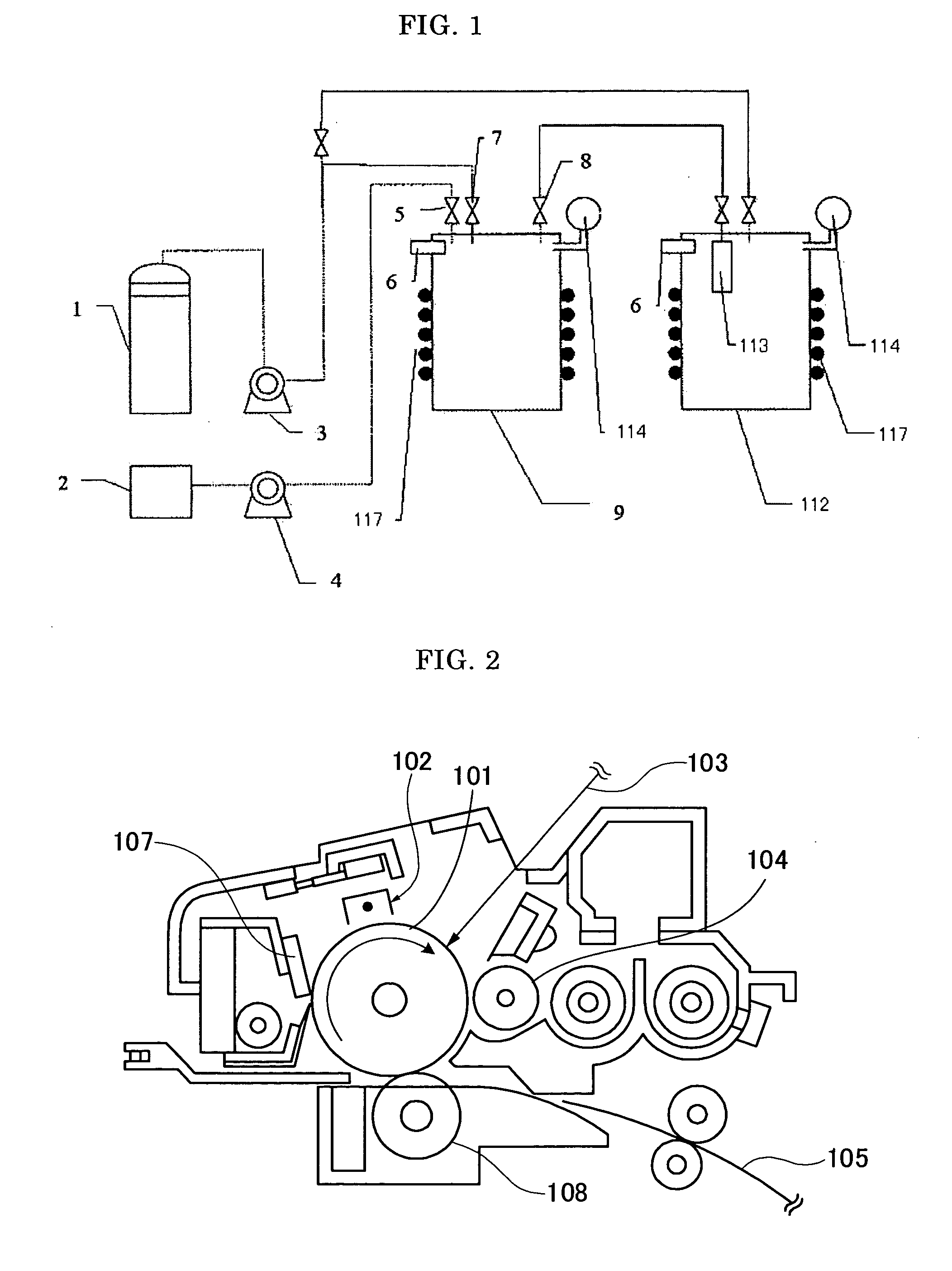Toner, production process for the same, and image forming method
a production process and technology of toner, applied in the field of toner, production process for the same, and image forming method, can solve the problems of reducing toner characteristics (e.g., flowability and charging properties), difficult control of the shape or structure of toner particles, and affecting the quality of toner, etc., to achieve excellent toner characteristics, reduce production costs, and improve the effect of quality
- Summary
- Abstract
- Description
- Claims
- Application Information
AI Technical Summary
Benefits of technology
Problems solved by technology
Method used
Image
Examples
synthesis example 1
Synthesis of Surfactant 1 (Perfluoroacrylate Resin)
[0247] A pressure-resistant reaction cell was charged with 30 parts by volume of perfluorooctyl acrylate per 100 parts by volume of the inner volume of the cell. Carbon dioxide as a supercritical fluid was supplied from a gas container to the reaction cell. The cell pressure was increased to 30 MPa using a pressure pump, and the cell temperature was increased to 80° C. using a temperature adjuster. To the reaction cell was added AIBN (azobisisobutyronitrile), a polymerization initiator, in an amount of 1 part by mass per 100 parts by mass of perfluorooctyl acrylate, allowing a reaction to take place for 24 hours.
[0248] After termination of the reaction, using a back pressure valve, supercritical carbon dioxide was removed to the outside at a flow rate of 5.0 L / min over 6 hours, and monomers left over were removed. Thereafter, the reaction cell was gradually brought to normal temperature and pressure (25° C., 0.1 MPa) to prepare “...
synthesis example 2
Synthesis of Surfactant 2
[0249] A pressure-resistant reaction cell was charged with 30 parts by volume of a monomer mixture consisting of 30 mol % perfluorooctyl acrylate and 70 mol % styrene per 100 parts by volume of the inner volume of the cell. Carbon dioxide as a supercritical fluid was supplied from a gas container to the reaction cell. The cell pressure was increased to 30 MPa using a pressure pump, and the cell temperature was increased to 80° C. using a temperature adjuster. To the reaction cell was added AIBN (azobisisobutyronitrile), a polymerization initiator, in an amount of 1 part by mass per 100 parts by mass of the monomer mixture, allowing a reaction to take place for 24 hours.
[0250] After termination of the reaction, using a back pressure valve, supercritical carbon dioxide was removed to the outside at a flow rate of 5.0 L / min over 6 hours, and monomers left over were removed. Thereafter, the reaction cell was gradually brought to normal temperature and pressur...
synthesis example 3
Synthesis of Surfactant 3
[0251] A pressure-resistant reaction cell was charged with 30 parts by volume of a monomer mixture consisting of 70 mol % Mono Methacrylopropyl Terminated Poly Dimethylsiloxane (MCR-M17, produced by AZmax, Corp.), 24 mol % styrene and 6 mol % butyl acrylate per 100 parts by volume of the inner volume of the cell. Carbon dioxide as a supercritical fluid was supplied from a gas container to the reaction cell. The cell pressure was increased to 30 MPa using a pressure pump, and the cell temperature was increased to 80° C. using a temperature adjuster. To the reaction cell was added AIBN (azobisisobutyronitrile), a polymerization initiator, in an amount of 1 part by mass per 100 parts by mass of the monomer mixture, allowing a reaction to take place for 24 hours.
[0252] After termination of the reaction, using a back pressure valve, supercritical carbon dioxide was removed to the outside at a flow rate of 5.0 L / min over 6 hours, and monomers left over were rem...
PUM
| Property | Measurement | Unit |
|---|---|---|
| Temperature | aaaaa | aaaaa |
| Percent by mass | aaaaa | aaaaa |
| Percent by mass | aaaaa | aaaaa |
Abstract
Description
Claims
Application Information
 Login to View More
Login to View More - R&D
- Intellectual Property
- Life Sciences
- Materials
- Tech Scout
- Unparalleled Data Quality
- Higher Quality Content
- 60% Fewer Hallucinations
Browse by: Latest US Patents, China's latest patents, Technical Efficacy Thesaurus, Application Domain, Technology Topic, Popular Technical Reports.
© 2025 PatSnap. All rights reserved.Legal|Privacy policy|Modern Slavery Act Transparency Statement|Sitemap|About US| Contact US: help@patsnap.com



